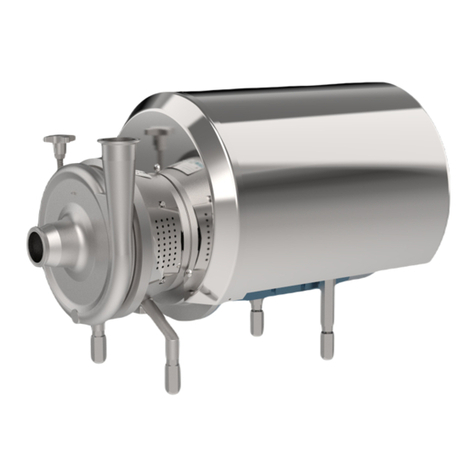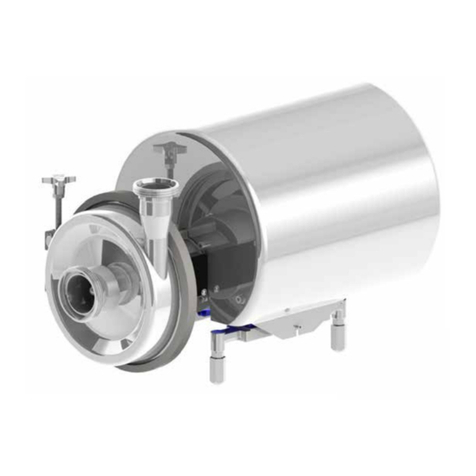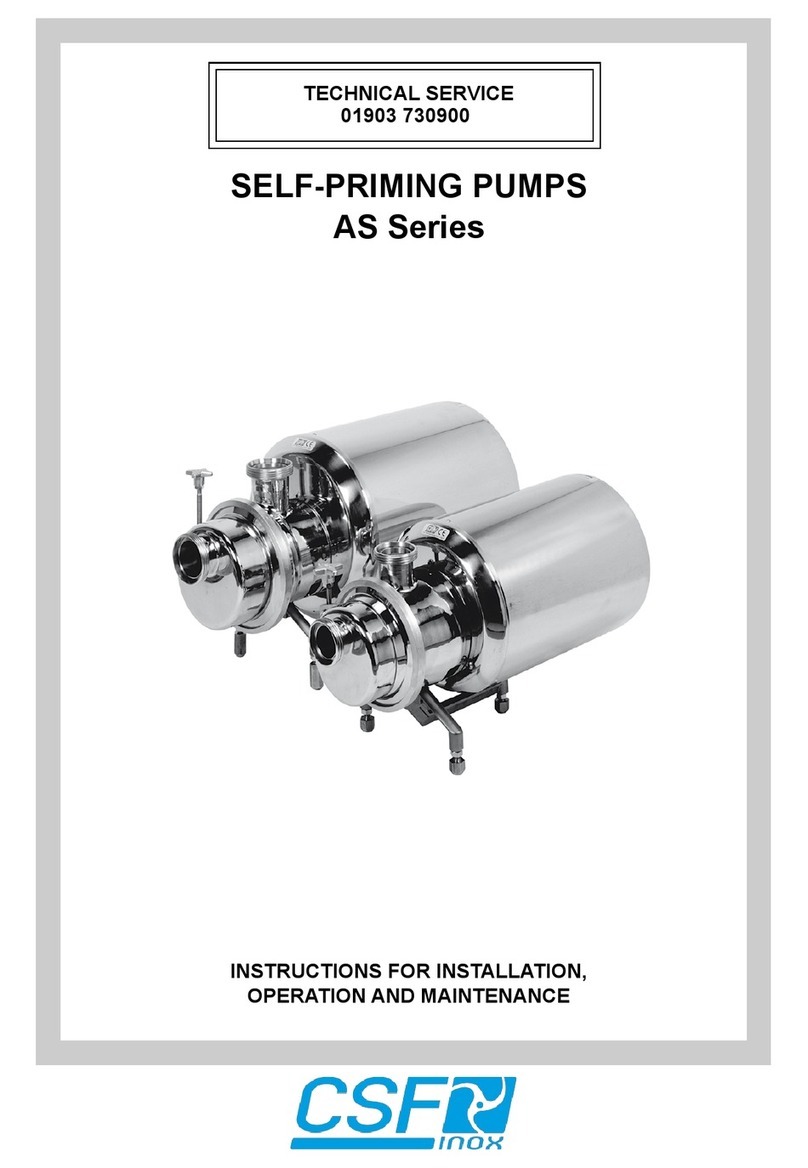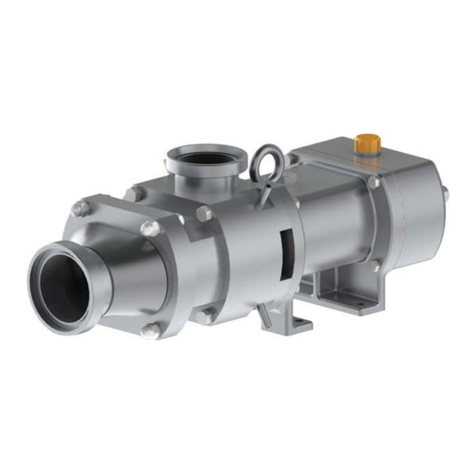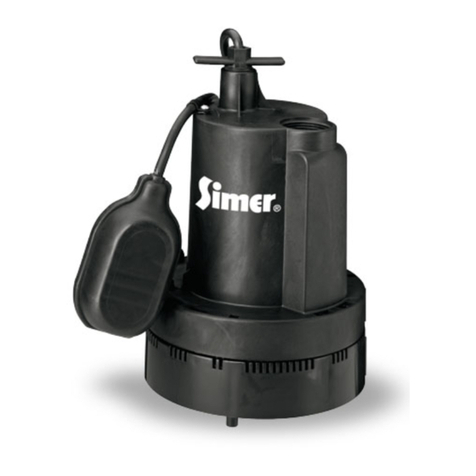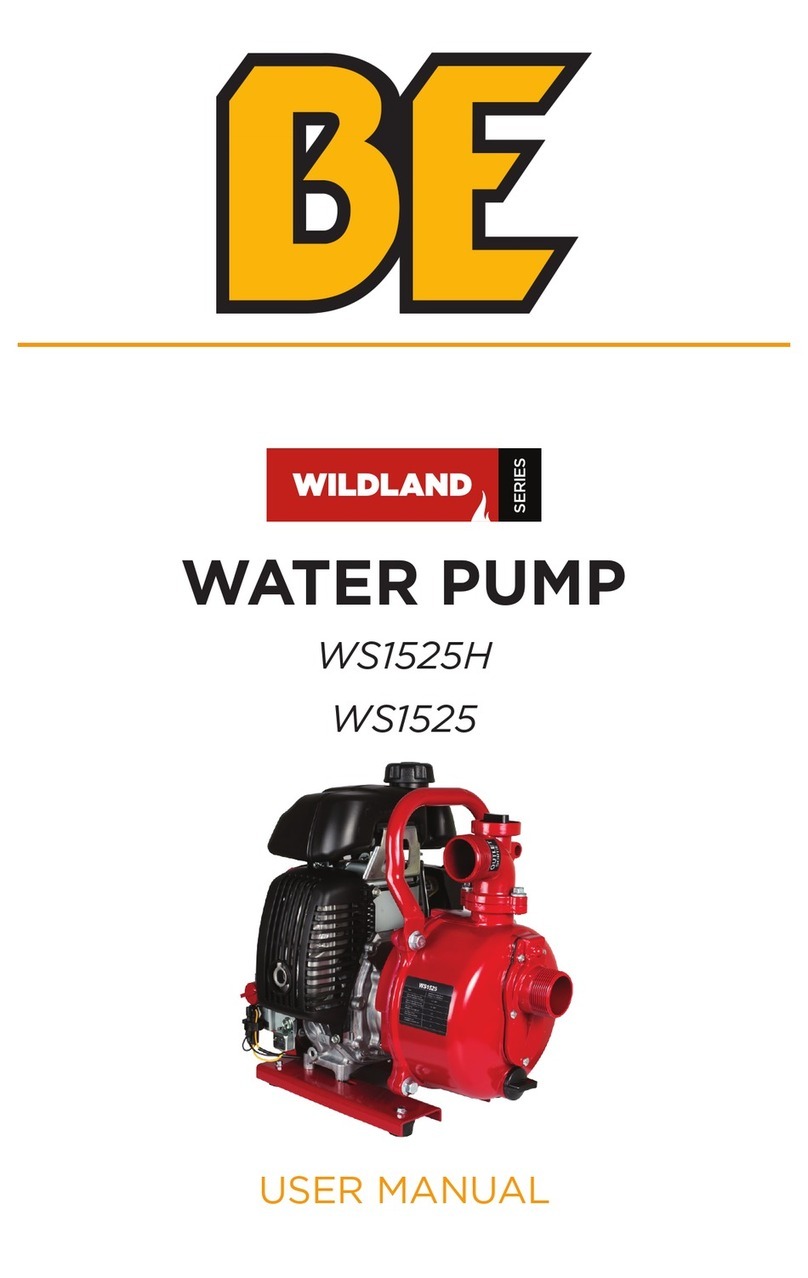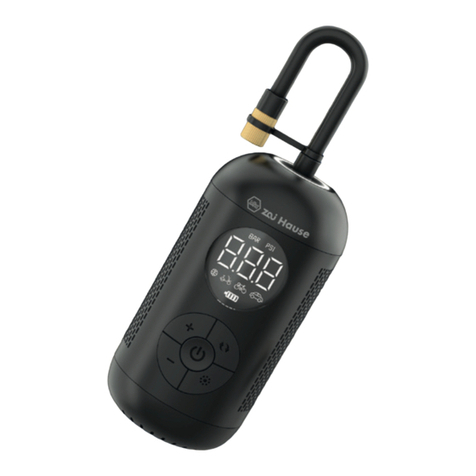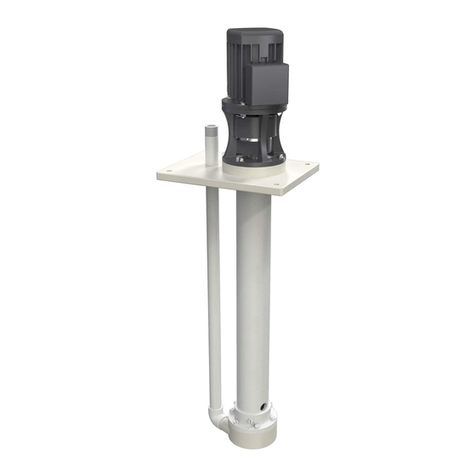CSF Inox CS 25-145 Programming manual

TECHNICAL SERVICE
01903 730900
CENTRIFUGAL PUMPS
CS Series
INSTRUCTIONS FOR INSTALLATION,
OPERATION AND MAINTENANCE

p. 2
"Translation of the original instructions"
INDEX
FOREWORD
1 SYMBOLS
2 SAFETY WARNINGS
3 GUARANTEE
4 GOODS TRANSPORTATION, RECEIVING AND TRANSFERRING
4.1 Transportation
4.2 Receiving
4.3 Transferring
5 DESCRIPTION
6 SETUPS
7 SOUND PRESSURE LEVEL
8 INSTALLATION - CSK SERIES
8.1 Type "A" elastic coupling assembly instructions
8.2 Coupling with spacer type A..-SP
8.3 Suctionandinowconditions
8.4 Piping
8.5 Electrical connection
9 NON-PERMITTED USES
10 OPERATION
10.1 Preliminary operations
10.2 Starting
10.3 Operating checks
10.4 Extended stop
10.5 Cleaning the pump
11 DISPOSAL OF THE PUMP
12 SPARE PARTS
12.1 Reference table of main parts subject to replacement
12.2 Recommended supply
13 WORKING IRREGULARITIES
14 SEALS
15 SINGLE MECHANICAL SEALS - CS / CSX / CSK
16 DOUBLE MECHANICAL SEALS - CS / CSX
17 DOUBLE MECHANICAL SEALS - CSK
18 DISASSEMBLY
18.1 Disassembly of CS pump "T/W" exec.
18.2 Disassembly of CS pump "Q" exec.
18.3 Disassembly of CS pump "V" exec.
18.4 Assembly of CS pump "T / W / V / Q" exec.
19 REFERENCE TABLE FOR ASSEMBLY ALLOWANCE
20 BEARINGS MAINTENANCE
20.1 Bearings maintenance for CS series pumps
20.2 Bearings maintenance for CS - CSX series pumps with housing size
160 ÷ 200
20.3 Bearings maintenance for CSK series pumps
20.4 Disassembly
20.5 Assembly
21 CLEANING PROCEDURE
Version : 14 Date : 30/06/16

p. 3
FOREWORD
- Read the instructions carefully and keep them for future consultation.
- C.S.F. Inox S.p.A. reserves the right to make any changes to the documentation it deems necessary
without being obliged Wto update publications that have already been issued.
- When requesting information, spare parts or assistance, always specify the pump type (*) and
serialnumber(**)inordertoensurefastandefcientservice:thecompletecodeisgivenonthe
plate and in the purchase documents.
Plate example
Mod. CS 50-175-2-10/B.PT31 (*)
N° C012345 (**)
Item.
RPM 2900
kW 7,5 Volt 380-660 Hz 50
1 SYMBOLS
2 SAFETY WARNINGS
When the pump is working the following occurs:
- Electric parts are in tension.
- Mechanical parts are moving.
- Pump body, pipelines and articulations are under internal pressure. Therefore do not remove any
protection or locking, do not loosen screws or clampings, as this can cause serious damage to
persons or objects. The clamp joining the pump casing and the lantern bracket must be well tightened
and it should not be easily unscrewed by hand. The tightening of the clamp must be carried out by
means of a spanner and NOT by hand.
- Non-observance of inspection and maintenance can cause damage to persons and objects,
especially when dangerous or toxic liquids are pumped.
- When pumping liquids at a temperature over 60° C, adequate protection and warning signals are
required.
- When you buy a pump with bare shaft, motor coupling operations have to be carried out according
to technical directions and law, providing adequate protections for joints, gear belts, etc.
- Operations on the electric parts have to be carried out by skilled personnel, according to technical
directions and law, on authorization of the responsible installer.
- Installation must ensure an adequate ventilation, in order to cool the motor, as well as enough
space for maintenance operations.
- Before carrying out any operation which requires to disassemble the pump (inspection, cleaning,
seal replacement, etc.), the following preliminary operations have to be carried out:
switch off the motor and disconnect electric power;
close valves on suction and outlet pipelines, in order to avoid the risk of inundation;
use adequate protections for hands and face, if the pump contains liquids which are injurious to
health (for example acids, solvents, etc.);
considerwhethertheliquidwhichowsoutofthepumpwhendisassemblingisdangerousand
arrange for adequate safety measures.
Pay the utmost attention to text blocks indicated by
this symbol.
Danger: failure to comply with these warnings can
cause serious harm to persons and/or objects.
Danger: only qualied personnel can carry out opera-
tions on the electrical part.
WARNING

p. 4
3 GUARANTEE
All products manufactured by C.S.F. Inox S.p.A. are guaranteed to the purchaser, for one
year from the date of purchase, against hidden defects in materials or manufacture, provid-
ing that they are installed and used according to instructions and recommendations of the
manufacturer. Excluded from the guarantee, other than distinctive wear and tear, are repairs
to damage caused by: improper use, abrasion, corrosion, negligence, defect of installation,
non-observance of inspection and maintenance, use of non-genuine spare parts, accidental
causes and from any action carried out by the purchaser not according to the normal instruc-
tions of the manufacturer.
WARNING Before returning any item to C.S.F. Inox S.p.A. to be replaced or repaired under
guarantee, inform the CustomerAssistance Ofce about the problem and follow instructions
of the manufacturer. Any item must be properly packed in order to avoid damage during the
transferring and a technical report explaining the fault occurred, must accompany the
returned item/s.
Any item with a presumed fault should be returned to C.S.F. Inox S.p.A. with shipment costs
at purchaser's charge, unless different agreements are given.
C.S.F. Inox S.p.A. will examine, repair and/or replace the returned piece and then send it back
to the purchaser on ex-works basis. Should the piece be found under warranty, no further
costs will be owed by the purchaser. If, on the contrary, the fault is not found under warranty,
all necessary reparations and replacements will be charged at normal cost to the purchaser.
Commercial parts incorporated in C.S.F. products are guaranteed by their corresponding
manufacturers.
4 GOODS TRANSPORTATION, RECEIVING AND TRANSFERRING
4.1 TRANSPORTATION
Thepackings of allpumpsmanufacturedbyC.S.F.InoxS.p.A.are dened whenplacingthe
order. Unless prior arrangements are given, goods will be packed only for transit conditions
and not for long-term storage; in case it should be necessary to store the pumps outside,
you are requested to cover the pumps appropriately in order to protect the electrical parts
(motor) from rain, dust, humidity etc.
4.2 RECEIVING
WARNING Whenreceivingthegoods, thewholenessofpackingmustbeveried,inorderto
identify possible damage to the content during transportation and to claim them immediately
to the carrier. Should any damage be ascertained, the following procedure must be observed:
- collect the goods with reservation;
- take the necessary pictures showing the damage;
- notify the carrier of the damage undergone, by registered airmail, sending at the same time
the pictures taken to show the damaged pieces.
4.3 TRANSFERRING
Carry the packed pumps as close as possible to the place of installation by means of ap-
propriate lifting devices and unpack them. During this operation take care, as unsteady parts
could fall down.
The material used for packing (wood, paper, cellophane, etc.) should be properly gotten rid
of, according to the corresponding rules in force in the receiver’ s country. After unpacking
the pump, use special lifting belts and move the pump-motor set to the place of installation;
never use the eyebolts on the motor to move the pump, as the eyebolts are for moving the
motor only. In versions complete with shroud, take the shroud off before moving the pump-
motor set, in order to avoid damage.

p. 5
5 DESCRIPTION
The CS series comprises single-stage centrifugal pumps with axial suction port, open centrifugal
impellerandtrapezoidalvolutecasing.Allmodelshavethreadedconnectionsforttingsaccording
toDIN11851standards (unless otherwise requested) andallmodelsarettedwithmechanical
seals. The materials used for the components and the mechanical seal are chosen according to
the liquid to be pumped.
Theyarettedwiththree-phaseelectricmotors,IP55protectionrating,unlessotherwisespecied.
They are intended for professional use.
These pumps are designed for applications where the liquid to be pumped:
- is not subject to pollution of any kind,
- is at a temperature between -30°C and +140°C,
- must under no circumstances come into contact with the outside environment,
- is chemically aggressive.
6 SETUPS
(1) CS - exec. with shroud with
adjustable feet kW 0.37 to kW 4
(2) CS - exec. with shroud with
adjustable feet kW 5.5 a kW 22
(1) CS - exec. without shroud with
adjustable feet kW 0.37 to
kW 4
(2) CS - exec. without shroud with
adjustable feet kW 5.5 a kW 22
CS - exec. without shroud with
xedfeet
kW 0.37 ÷ 22
(1) CSX - exec. with shroud kW 30
(2) CSX - exec. without shroud
kW 30
CSK - exec. with bare shaft (for
coupling with base and joint)
(1) (2)
(1) (2)
(1) (2)

p. 6
Pump type
Sound pressure level dB(A)
< 70
71÷75
76÷80
CS 25-145 4-poles CS 25-175 4-poles CS 32-110 4-poles
CS 32-145 4-poles CS 32-175 4-poles CS 32-210 4-poles
CS 32-260 4-poles CS 40-145 4-poles CS 40-175 4-poles
CS 40-210 4-poles CS 40-260 4-poles CS 50-145 4-poles
CS 50-175 4-poles CS 50-210 4-poles CS 50-260 4-poles
CS 65-145 4-poles CS 65-175 4-poles CS 65-210 4-poles
81÷85
86÷90
CS 25-145 2-poles CS 25-175 2-poles CS 32-110 2-poles
CS 32-145 2-poles CS 32-175 2-poles CS 65-260 4-poles
CS 80-175 4-poles CS 80-210 4-poles CS 80-260 4-poles
CS 32-210 2-poles CS 40-145 2-poles CS 40-175 2-poles
CS 40-210 2-poles CS 50-145 2-poles CS 50-175 2-poles
CS 50-210 2-poles
CS 65-210 2-poles CS 65-260 2-poles CS 80-210 2-poles
CS 80-260 2-poles CS 100-210 2-poles CS 100-260 2-poles
7 SOUND PRESSURE LEVEL
The sound pressure level of centrifugal pumps is the following (see table):
The measurement has been made by means of a sound level meter placed 1 m from the pump and
at a height of 1.6 m from the ground.
Thepreliminaryconditionisthatthepumpisxedcorrectly;theabove-mentionedvaluesdonottake
intoaccountexternalnoisesources(e.g.valves,abrupthydraulicdeections).
8 INSTALLATION - CSK SERIES
The pump/motor set is aligned on the base at C.S.F., before delivery.
After installation has been performed, bounding the set to the foundation and the suction and outlet
pipelineshavebeenconnected,alignmentmustbeveried.
Before starting the unit, install a protective joint cover; it must be removed by specialised personnel
to perform inspections and/or maintenance only after having stopped the unit and disconnected
electrical power.
Warning: Misalignments and forcing cause stress and vibrations on transmission causing wear and
tear and premature breakage of the joint and bearings.
8.1 TYPE "A" ELASTIC COUPLING ASSEMBLY INSTRUCTIONS
1. ASSEMBLING THE HUBS
Oncethehubshavebeenttedontheshafts,andpriortoliningthemup,donotforgettoleavethe
attachment ring fastened onto one of the hubs. Check the pressure setscrews on the hubs are tight.
If the coupling is used in Ex. hazardous areas, the pressure setscrews should be additionally secured
against spontaneous loosening in the attachment of the hub to the shaft; for example, using Loctite
(medium strength) or similar.
CS 32-260 2-poles CS 65-145 2-poles CS 100-260 4-poles
CS 40-260 2-poles CS 65-175 2-poles CS 125-260 4-poles
CS 50-260 2-poles CS 80-310 4-poles CS 100-310 4-poles
CS 80-175 2-poles

p. 7
2. RADIAL ALlGNMENT
The radial alignment is controlled with a rule or a dial indicator or laser. By resting the rule on the
peripheryofthehubsandmatchinguptwooppositeteeth,youwillhaveasufcientlybroadlineof
contact to check they match up throughout their surface area. Better alignment precision is obtained
with the help of a dial indicator or laser (keep to radial tolerance Y).
3. AXIAL AND ANGULAR ALlGNMENT
Position the hubs at distance E, as for Table 1. Using the thickness feelers, you can control the
gap between hubs, measurement E (keep to axial tolerance X). It is advisable to check the values
of measurement E in three positions (O-90-180 degrees), as this will ensure more precise angular
alignment (keep to angular alignment Z).
4. ASSEMBLING THE ELASTIC INSERT
Once the two hubs have been aligned, proceed to assemble the elastic insert in the slots formed by
the parallel teeth. If the radial and angular alignment is correct, the ends of the elastic insert, once
closed, should match up intheir development and width. The elastic insert has two types of housing:
a through housing, with dual inlets, for horizontal work, and a single-inlet housing for vertical work.
5. ASSEMBLING THE RING
Oncetheelasticinserthasbeentted,theretentionringcanbeinsertedmanually,bymatchingup
one of the two reference Iines on the outside of the ring with the insertion grooves on the elastic insert.
Using a nylon mallet, install the retention ring, tapping alternately on each side of the two areas of
the reference marks, until the ring's lugs are coupled into the central housings of the elastic insert.
6. SECURING THE RING
Once the ring has been installed on the elastic insert, it needs to be fastened by inserting the two
set screws (Tab. 2) into the threaded housings, which match up with those for the elastic insert. We
recommend securing the tightness of the setscrews by applying Loctite (medium strength) to the
screw-threading. Any potential axial displacement of the ring, due to misalignment of the equipment,
is thereby secured.

p. 8
7. DISASSEMBLY
Remove the two set screws from the ring. Shift
the ring by tapping it on the side with a nylon
hammer in the areas the pins (reference lines)
are housed.
TAB. 1 MISALIGNMENT ADMISSABLE
Type A00 A0 A1 A2 A3 A4 A45 A5 A55 A6 A7 A8 A9 A10 A11
E1.5 1.5 1.5 2.5 2.5 3.5 3.5 3.5 3.5 3.5 4 5 5 6 6
Axial X +0.3 +0.3 +0.5 +0.5 +0.7 +0.8 +1.0 +1.0 +1.0 +1.0 +1.0 +1.5 +1.5 +1.5 +1.5
Radial y 0.2 0.3 0.3 0.5 0.5 0.7 0.7 0.7 0.8 0.8 1.0 1.0 1.0 1.5 1.5
Angular Z 0.10 0.10 0.20 0.20 0.30 0.40 0.40 0.50 0.50 0.60 0.90 1.10 1.30 1.70 1.70
TAB. 2
Type A00 A0 A1 A2 A3 A4 A45 A5 A55 A6
DIN 913 - - M5 M6 M8 M8 M10 M10 M10 M10
L- - 8 12 12 14 14 14 14 14
DIN 913
8.2 COUPLING WITH SPACER TYPE A..-SP
1. ASSEMBLING THE HUBS
Oncethehubshavebeenttedandsecuredwiththesetscrews,proceedtolinethemup,leaving
gapDBSE(140mm)toinsertthespacerbody.Donotgorgettottheattachmentringrst.
2. ALIGNMENT AND ASSEMBLY
Oncethespacerbodyhasbeenattachedtotheangehub,andthescrewssecuredwiththeirtighte-
ning torque (table 4), position the hub and the spacerbody at distance E, as for table 3 (keeping to
axial tolerance X).
Next, proceed in the same way as for alignment and assembly of coupling A.
TAB. 3
= MISALIGNMENT ADMISSABLE = Dimensions (E) and tolerances in mm.
Type A1C A2C A3C A4C A45C A5C A55C A6C A7C A8C
E3.0 3.0 3.5 3.5 3.5 3.5 4.0 4.0 4.0 4.0
Axial X +0.5 +0.5 +0.7 +0.8 +1.0 +1.0 +1.0 +1.0 +1.0 +1.5
Radial Y 0.1 0.1 0.15 0.20 0.20 0.20 0.20 0.20 0.30 0.30
Angular Z 0.20 0.20 0.30 0.40 0.40 0.50 0.50 0.60 0.90 1.1
TAB. 4
FLANGER CAP SCREWS TIGHTENING TORQUES
Type A1 A2 A3 A4 A45 A5 A55 A6 A7 A8
DIN 912 M6 M6 M8 M8 M10 M10 M10 M10 M12 M14
TQ (Nm.) 14 14 35 35 69 69 69 69 120 205

p. 9
Fig. 2
Fig. 3
8.3 SUCTION AND INFLOW CONDITIONS
(NPSH = Net Positive Suction Head)
NPSH of system (available NPSH)
In order to ensure that pump operation is free from cavitation, it is essential to observe the maximum
permitted suction lift ha geo max or the minimum allowable head hc geo min.
NPSH of pump (required NPSH)
The centrifugal pumps can operate correctly only if vapour has not formed inside. For this reason
the static head at the reference point for the NPSH is the centre of the impeller, that is the point of
intersection of the pump shaft axis with the vertical plane that passes through the external points
of the blade inlet corners.
NPSH is the value required by the pump, expressed in metres, obtained from the performance curve.
In practice 0.5 m should be added to this value as a safety margin.
8.4 PIPING
In order to prevent the creation of harmful strains, the suction and discharge pipes must be con-
nected to the pump ports without the use of force. These pipes must also be supported indepen-
dently avoiding causing stress on the pump. The internal diameter must be the same size as the
pump connections. It must in any case not be smaller to avoid head loss and/or poor performances.
Always use elbows with large radius. If the pipe diameter changes along the line, use reduction
cones, choosing the ones that are most suitable to avoid any formation of air pockets (Fig. 1).
YES
NO
Fig. 1
The suction pipe must be as short as possible and rise as it moves towards the pump if it is sucking
from a tank (Fig. 2). If on the other hand the pump is below the level of the liquid, the pipe should
descendslightly(Fig.3).Ifthepumpisusedfortransportinghotliquids,texpansionjointstocom-
pensate any expansion of the piping. The maximum velocity of the liquid in the suction pipe must
not be greater than 3 m/s. Velocities between 1 and 2 m/s are recommended. The suction pipe must
be designed in such a way as to prevent air from entering the pump.

p. 10
For this reason, when sucking from a tank located at a lower level, the pipe must reach below the
free surface of the liquid. In order to prevent the formation of vortices and avoid the risk of sucking
in air, always keep a minimum head at the pipe inlet (h. min.) equal to at least the dynamic head
plus a safety margin of 0.1 m (Fig.2).
Va2
2g
hmin = m
V = m/s
h min = + 0,1
In order to prevent the formation of vortices when it is not possible to observe the values of minimum
availablehead,itispossibletotcrossesinthepiping.Thissystemissuitableevenfortankswith
a positive head.
-Avoidcreatingobstacleswhichcouldincreasesuctionlossesdisruptingsmoothuidow.Make
sure that there are no restrictions, sharp turns or tight elbows on the discharge line, since these
increase disturbance.
8.5 ELECTRICAL CONNECTION
Make the electrical connection only after the hydraulic connection has been completed; set up the
motor control system in conformity with the technical standards and regulations in force (EN 60204-
1): in particular a manual electric power switch must be installed with adequate current switching
capacity; devices for overcurrent and overload protection (e.g. fuses, automatic switches, etc.) must
alsobetted,plus,ifnecessary,adevicetopreventaccidentalrestarting.
Check that the main frequency and voltage and the available power are suitable for the motor
installed. All the material used for the electrical connection (cables, cable clamps, switches and
shielding) must have a suitable level of protection for the environment in which it is installed. Be sure
tousecablesofsufcientcross-sectionforthecurrentshownonthemotorplatesoastoprevent
them from overheating.
Before doing anything else, make the motor's earth connection, using the terminal on the motor
andacableofsufcientcross-section.Thecablesmaybeconnectedtotheterminalboardusing
either a delta or star arrangement. Follow the data given on the motor plate for the main voltage, as
showninthediagraming.4.Whenstarting,themotor'scurrentabsorptionincreasesbrieyto5-6
times the nominal value. If the mains supply is unable to sustain this increase in absorption, use a
star-delta starter or other kind of device (e.g. an autotransformer).
Fig.4
Lower
voltage
Higher
voltage
C.S.F. Inox S.p.A. will accept no responsibility for damage to property and/or injury to persons caused
by failure to comply with technical standards and regulations in force.
9 NON-PERMITTED USES
Donotusethepumpwithasuctionpressuregreaterthanthespeciedvalue(0.5timesthedischarge
head generated by the pump).
The pump must always be used in an environment appropriate to the level of protection of the motor.
Always check this on the motor plate before installation.
WARNING THE PUMP MAY NOT BE USED IN ENVIRONMENTS WHICH REQUIRE A HIGHER
LEVEL OF PROTECTION OR A HIGHER SPECIFICATION MOTOR OR ELECTRICAL PARTS.
Components complying with the safety standards for the environment in question must be used.

p. 11
10 OPERATION
10.1 PRELIMINARY OPERATIONS
- Check that the pump turns freely under hand pressure.
- Check that the clamp joining the pump casing and the lantern bracket is well tightened and that it
cannot be easily unscrewed by hand. The tightening of the clamp must be carried out by means of
a spanner and NOT by hand.
- Check that the pump turns in the marked direction (CLOCKWISE, as seen from motor end).
-Thesuctionpipeandthepumpmustbelledwithliquid.Therearetwopossiblecases:
a) When the pump is to operate with a negative suction head, it must be primed by introducing
liquid into the pump body.
b) When the pump is to operate below the level of the suction liquid, i.e. with a positive head, the
suction and discharge gate valves must be opened until the pressure gauge on the pump discharge
shows a pressure corresponding to the positive suction head.
-Ifthesealingchamberistobecooled,openthecoolingwatersupplyandadjusttheow.
10.2 STARTING
- Carry out the preliminary operations, then close the discharge valve completely and make sure
that the suction valve is completely open.
- Start the pump and check once again that it rotates in the right direction.
10.3 OPERATING CHECKS
- If the pump does not generate the required discharge head rapidly, stop and repeat the priming
operations.
-Ifthedischargegatevalveisopenedmorethannecessary,i.e.furtherthanthespeciedworking
point, and the pump is operating with a lower discharge head than that required, there will be an
increase in delivered capacity and absorbed power. If this occurs, throttle the discharge until the
required head and capacity values are obtained.
- If the discharge head generated by the pump is greater than that required, the diameter of the
impeller can be reduced. If, on the contrary, the discharge head is lower than required, with the same
capacity,itwillbenecessarytoinstallalargerdiameterimpeller(iftheonettedisnotalreadythe
largest available) and probably also an higher power motor.
- The pump must operate smoothly and without vibrations.
- Do not operate without liquid and in any case avoid prolonged operation with the discharge gate
valve closed.
-Checkthatthesuctionliquidlevelisalwayssufcienttograntanadequateenergyloadfornormal
operation of the pump.
- Mechanical seal: check that there is no leakage along the shaft.
10.4 EXTENDED STOP
When stopping the pump for a longer time, empty the pump completely and wash it accurately in
order to avoid the formation of scales and/or encrustations. When starting the pump again, please
follow the above-mentioned instructions.
10.5 CLEANING THE PUMP
The pump does not require any special washing procedures. The washing cycles normally used
for the plant in which it is installed are quite satisfactory. When using the pump for liquids that tend
to harden or crystallize, always make sure it is washed before taking the machine out of operation.
This will ensure durability of the seal and of the pump itself. It is the user's responsibility to ensure
that the washing liquids are compatible with the process liquid and the pump.
11 DISPOSAL OF THE PUMP
For disposing the pump please observe the following instructions:
- disconnect electrical and hydraulic connections according to technical rules and laws in force.
- Disassemble all components of the pump for separate dismantling; wash the components and
clean the structure accurately.
The main components of the pump are made from the following materials:
- pump casing, cover, impeller, S.S. Aisi 316L
shaft, impeller nut
- elastomers NBR-EPDM-FLUOROCARBON (FPM)-PTFE
- motor Aluminium - Cast iron - Copper
Components made from asbestos or lead are not used in our production.
WARNING The components of the pump should be properly gotten rid of, according
to the corresponding rules in force in the receiver’s country.

p. 12
12 SPARE PARTS
12.1 REFERENCE TABLE OF MAIN PARTS SUBJECT TO REPLACEMENT
Pump type
CS-CSX
32-110 25-145 25-175
32
40
50
65
32
40
50
65
32
40
50
80
65
80
100
32
40
50
65
80
100
125
80
100
125
150
Part -145 -175 -210 -175 -210 -260 -310 -350
* Mechanical seal
EN12756-ISO3069 D.20 D.28 D.43 D.55
Pump casing “O-Ring” OR 6412 OR 215 OR 6670 OR
215
OR
6670
OR
6795
OR
6670
OR
6795
OR
6995
OR
61200 OR 81300
Impeller nut “O-Ring” OR 2087 OR 2112 OR 2150 OR 3206
Bearing
IEC 71 3205 --- ---
---
IEC 80 3207 A 2RS-C3 3208 A 2RS-C3 3208 A 2RS-C3
IEC 90
IEC 100 3208 A 2RS-C3 3208 A 2RS-C3 3208 A 2RS-C3
IEC 112
IEC 132 --- 3210 A 2RS-C3 3210 A 2RS-C3
IEC 160 --- 3212 A C3 3214 A C3
IEC 180 --- 22214 E 22214 E
IEC 200
(CSX)
--- --- C 2216.C3
--- --- 6216 A.C3
“Gaco” seal
ring
IEC 160 --- AS 70x90x10 AS 80x100x10
IEC 180 --- AS 80x100x10 AS 80x100x10
“V-Ring” IEC 200
(CSX)
--- --- V-Ring 90
--- --- V-Ring 75
Pump type
CSK
32
40
50
65
32
40
50
65
32
40
50
80
65
80
100
32
40
50
65
80
100
125
80
100
125
150
Part -145 -175 -210 -175 -210 -260 -310 -350
*Mechanical seal
EN12756-ISO3069 D.28 D.43 D.55
Pump casing “O-Ring” OR 215 OR 6670 OR 6795 OR 6670 OR 6795 OR 6995 OR 61200 OR 81300
Impeller nut “O-Ring” OR 2112 OR 2150 OR 3206
Bearings
Front 3206 3309 3311 C3
Rear 6206 6309 6311 C3
“Gaco” seal
ring
Front AS 40x47x7 AS 45x62x8 AS 55x72x8
Rear AS 40x47x7 AS 45x62x8 AS 55x72x8
Speedi sleeve D. 30 - CR99114 D. 45 - CR99177 D. 55 - CR99215
* NB:
The type and materials of the rings are
identiedintheenclosedtechnicalpartslist
RECOMMENDED SPARE PARTS FOR TWO YEARS OF OPERATION
ACCORDING TO THE NUMBER OF PUMPS INSTALLED - VDMA STANDARDS
Denomination
NUMBER OF PUMPS
(including reserve)
12345
MECHANICAL SEAL 12344
PUMP COVER O-RING SEAL 23567
IMPELLER NUT O-RING 23567
BEARING 12344
GACO Ring (for motor powers over kW 11) 1 2 3 4 4
12.2 RECOMMENDED SUPPLY
C.S.F. Inox declines all responsibility for damage or injury resulting from the use of non-original spare parts.

p. 13
13 WORKING IRREGULARITIES
We are herewith listing some of the possible working irregularities which may occur using the pumps,
withatablehelpingtondoutthepossiblecausesandhowtosolvetheproblem.
Trouble:
A) The pump does not run
B)Thedeliveryisnotsufcient
C)Thepressureisnotsufcient
D) The pump stops priming
E) Power absorption too high
F) Leakages from the mechanical seal
G) Short life of the mechanical seal
H) Failure of the mechanical seal
I) Anomalous vibrations and/or noise
L) Short life of bearings
Possible causes and necessary operations to solve them:
1) The pump is not properly primed.
- Repeat the priming.
2) Air entering from suction connections.
- Check the lock.
3) Air entering from the mechanical seal.
- Replace the mechanical seal or arrange a solution with a vacuum spring in case of vacuum suc-
tion operation.
4) Obstructions present along suction pipes or valves closed along pipes.
-Verifyandremoveallforeignmatterfrompipesandnallyverifyvalvestatus(ifclosed,openthem).
5) NPSH available in the plant is lower than NPSH needed by the pump.
- Reduce the friction loss or adjust the pump at a lower delivery point.
6)Defectiveoperationofthestandingvalve(notoodedpumps).
- Restore the proper operation of the valve or replace it with a perfect one.
7) Plant friction losses higher than pump performances.
- Reduce friction losses or replace the pump with a more suitable one for requested performances.
8) Opposite direction of rotation or too low velocity (in case of a pump operated by an inverter).
- Restore the correct direction of rotation; increase the motor speed.
9) The impeller is clogged by foreign matter (in case of pump with closed-impeller).
- Remove foreign matter from the impeller.
10) Worn mechanical seals.
- Replace worn parts.
11) Worn or partially clogged impeller.
- Replace the impeller or remove foreign matter.
12) Product viscosity higher than foreseen.
- Verify the pump size.
13)Presenceoftoomuchgasintheuid.
- Fit an air relief valve.
14) Plant friction losses lower than foreseen.
- Increase friction losses or adjust the pump at a higher working point.
15)Fluidspecicgravityhigherthanforeseen.
- Increase the installed motor power.
16)Pumpeduidtooviscous.
- Verify the pump size.
17) Higher pump delivery during operation due to plant friction losses lower than foreseen.
- Adjust the pump at a lower working point or increase the plant friction losses.
18) Rotation speed too high (when pump is controlled by an inverter).
- Reduce the velocity.
19)Internalfrictionscausedbyslippingbetweenrotatingandxedparts.
- Restore normal assembly conditions.
20) Misalignment of pump-motor or deformed shaft.
- Restore the correct alignment between pump and motor; replace the shaft with a new one.
21) Damaged bearings of pump or motor.
- Replace the bearings.
22) Electric misconnection.
- Modify the electric connection by strictly following ratings written on the motor plate according to
the available voltage.

p. 14
A B C D E F G H I L
1
2
3
4
5
6
7
8
9
10
11
12
13
14
15
16
17
18
19
20
21
22
23
24
25
26
27
28
29
30
31
32
33
34
35
36
37
38
39
POSSIBLE CAUSES AND NECESSARY OPERATIONS TO SOLVE THEM
TROUBLE

p. 15
23) Voltage not suitable for the installed motor.
- Replace the motor with one having a suitable voltage.
24) Mechanical seal worn.
- Replace the mechanical seal.
25)Pumpuidortemperaturenotsuitablefortheassembledmechanicalsealoritsparts.
- Verify the mechanical seal selection.
26)Non-cleaningwhenusinguidswhichtendtocrystallize.
- Increase washing cycles and don’t leave the product inside the pump for a long time.
27) Misassembly of the mechanical seal.
- Assemble the mechanical seal again with attention.
28) Opposite rotation direction for non-reversible mechanical seals.
- Restore the correct direction of rotation.
29)Flushingnonsufcientforexternalushedseals.
-Increasetheushinguid.
30) Dry operation of the pump.
- Arrange the proper dry-running protection in order to avoid the problem.
31) Oscillations on the shaft due to a too high assembly allowance, worn bearings, etc.
- Restore normal assembly conditions by replacing the worn pieces.
32)Suspendedsolidpartsintheuid.
- Verify the mechanical seal selection.
33) Too high temperature or thermal shock.
-Increasegraduallytheuidtemperaturebyavoidinginstantaneousthermalamplitudes;prevent
the pump from dry-running.
34) Out-of-balance of the impeller.
- Replace the impeller.
35)Thepumprunsatalowowrate.
- Adjust the pump at a higher working point.
36)Thepumprunsatahighowrate.
- Adjust the pump at a lower working point.
37) Pump and/or pipes are not properly anchored.
- Verify and adjust anchorage of the involved parts.
38) Bearings not lubricated (where lubrication is foreseen).
- Replace bearings and restore their proper lubrication, which must be topped up from time to time
according to work conditions.
39) Water seepage due to worn oil retainers.
- Replace worn parts.
14 SEALS
AllC.S.F.pumpsoftheCSseriesarettedwithuniedmechanicalsealsaccordingtoEN12756-ISO
3069standards,inordertogranttheinterchangeability(subjecttovericationofaxialspace).Thetype
of mechanical seal and material are chosen according to the liquid to be pumped.
WARNINGBeforeusingthepumpforanyliquidsotherthanthosespeciedwhenselectingand
ordering, ensure that mechanical seals and gaskets are suitable for the new product.
METALS
H- Nickel-plated stainless
steel AISI 304
X- Stainless steel AISI 316L
L- Hastelloy (Ni alloy)
CARBONS
V- Normal carbon
Z- Special carbon
RESINS
5- Normal PTFE
4- Loaded PTFE
F- O-RING FEP
METAL CARBONS
3- Hard metal welded on
stainless steel (TUC)
R- Integral anti-corrosion
hard metal (TUC)
K- Integral silicate carbon (SIC)
METAL OXIDES
2- Alumina ceramic
ELASTOMERS
6- Nitrile (NBR)
7- Ethylene propylene (EPDM)
W- FPM for high T
Y- Fluorocarbon (FPM)
B- Silicone
Q- Chemraz
U - Kalrez
MATERIAL CODES

p. 16
EXECUTION T / W
STANDARD MECHANICAL SEAL “T”
Standard execution foresees the assembly of an submerged internal
mechanicalsealontheproduct,housedbehindtheimpellerinaspecic
tapered chamber so as to guarantee correct lubrication conditions.
MECHANICAL SEAL WITH CIRCULATION "W"
Internal mechanical seal with circulation
forced by the pumped liquid.
15 SINGLE MECHANICAL SEALS - CS / CSX / CSK
EXECUTION TH-WH
INTERNAL MECHANICAL SEAL “TH-WH”
Protected and balanced. It is easy to clean and therefore ideal for
sanitary, pharmaceutical use etc.
W= Execution with circulation forced by pumped liquid..
EXECUTION Y
EXTERNAL MECHANICAL SEAL “Y”
For all cases where the mechanical seal must not touch the pumped
product, in order to avoid sanitary problems, corrosion and conditioning
of its running.
EXECUTION V
INTERNAL MECHANICAL SEAL “V”
The external liquid circulation chamber creates a protective barrier in
the presence of aggressive or toxic liquids. The function is to clean the
seal faces in order to limit wear.

p. 17
16 DOUBLE MECHANICAL SEALS - CS / CSX /
EXECUTION Q
COMPACT DOUBLE MECHANICAL SEAL “Q”
Double mechanical seal with circulation of washing and cooling liquid.
Thefunctionofushingisthatofcleaning,lubricatingandcoolingthe
seal; the liquid in circulation must be clean. If the seal is leaking, the
ushingliquidwillpointoutthisfault.
A = assembly measurement
D = 20 11 mm
D = 28 8 mm
D = 43 20.5 mm
17 DOUBLE MECHANICAL SEALS - CSK
EXECUTION Q FOR CSK SERIES
DOUBLE MECHANICAL SEAL “Q”
Double mechanical seal (back-to-back) with liquid circulation. The
functionofushingisthatofcleaning,lubricatingandcoolingtheseal;
theliquidincirculationmustbeclean.Ifthesealisleaking,theushing
liquid will point out this fault.
A = assembly measurement A = assembly measurement
D = 28 42 mm D = 55 86,5 mm
D = 43 70 mm
A = assembly measurement
D = 55 86,5 mm

p. 18
"Q" and "V" Exec. mechanical seal auxiliary ushing
Upontherststartup,thellingofthepump,mustbeguaranteed.Furthermore,youmustguarantee
thefullllingoftheauxiliarysystems,ifpresent,suchasthelubricationcircuitoftheexternaldual-
seal(sealexecution“Q”)ortheexternalushingcircuit(sealexecution“V”).
Lack of compliance with the present requirements causes the dry operation of the pump and of the
mechanical seal; consequently the mechanical seal can be overheated and damaged.
The auxiliary services (optional) are the following:
-ushingforthedoubleexternalmechanicalseal(sealexecution“Q”)
-externalushingfortheinternalseal(execution“V”).
The following conditions are recommended:
Exec."Q":incaseofleaksfromtheprocessseal(pumpside)theushingliquidcomesintocontact
withthepumpuid;alwaysuseaushingliquidthatiscompatiblewiththeprocessliquid.
Theushingmustbearrangedwithapressurevalueof0,5÷1Barhigherthanthepressureforeseenatthe
suction, in order to have the right compensation.
The mixing of incompatible liquids can cause strong exothermic reactions with the development
of heat.
Inthepresenceofdangerousliquidsand/oruseofushedseals(execution“Q”-“V”)thepresence
oftheushingliquidmustbemonitoredbymeansofasystemthatcanintervenetostopthepump
incaseofushingliquidabsence.
In the presence of liquids dangerous to health and/or the environment, it is advisable to insert a
monitoringdeviceofthesealushingliquidthatcanintervenetostopthepumporasanalarmsign,
incaseofcontaminationoftheushingliquid.
Operation checks
Verifythepresenceofushingofthemechanicalseal(execution“Q”-“V”).
Verify the absence of leaks from the auxiliary service connections of the seal (if present).
Mechanical seal Ø Flushing pipe Speed Capacity
l/min Pressure bar
Q 1st Gr. 20 Ø 1/8" Gas male 1450-2900 0,2-0,5 See seal instructions
Q 2nd Gr. 28 Ø 1/8" Gas male 1450-2900 0,5-1,0 See seal instructions
Q 3rd Gr. 43 Ø 1/8" Gas male 1450-2900 0,7-2,0 See seal instructions
Q 4th Gr. 55 Ø 1/4" Gas male/female 1450 0,8-2,2 See seal instructions
V 1st/2nd Gr. 20-28 Ø 1/8" Gas male 1450-2900 0,2-0,5 0,5-1,0
V 3rd Gr. 43 Ø 1/8" Gas male 1450-2900 0,5-1,0 0,5-1,0
V 4th Gr. 55 Ø 1/4" Gas female 1450 0,8-1,5 See seal instructions

p. 19
18 DISASSEMBLY
18.1 DISASSEMBLY OF CS PUMP "T/W" EXEC.
(Version with single mechanical seal)
A- Remove the screws (42-81) to disassemble
shroud (41) and protections (80).
- Remove screws (36) from motor and pull it
off the pump.
- Disassemble the front and rear foot (20-23)
with the screws (24).
NB: THE FOLLOWING OPERATIONS MUST BE CARRIED OUT PLAC-
ING THE PUMP UPRIGHT
B- Loosen the clamp (13) to pull out
the pump casing (1) and O-ring (18).
C- Unscrew the nut (14) anti-clockwise; this operation can be
carried out:
1) with a pneumatic wrench
2) usingaxedwrenchblockingthepumpshaftonthemotorend.
NB: if the motor has not been disassembled, the fan cover can
be removed and the motor shaft blocked with self-locking pliers.
NB: Hexagon dimension of the impeller nut (14):
CS 1st Gr. CH=20
CS 2nd Gr. CH=26
CS 3rd Gr. CH=36
CS 4th Gr. CH=50
Remove the impeller (3) and the shims (19) which implement
assembly play.
D- Extract the rotary part of the
mechanical seal (7) turning the
spring anti-clockwise.
Separate the cover (2) from the
lantern bracket (5), pull off the
xed part of the mechanical seal
(7) housed on it.

p. 20
E- Turn it over to access the screws (35)
which allow you to separate the support (6)
from the lantern bracket (5).
18.2 DISASSEMBLY OF CS PUMP "Q" EXEC.
(Version with double mechanical seal)
1st Phase: carry out the operations as in parag. 17.1 (A-B-C)
2nd Phase: after having disassembled the ushing
pipes (39) separate the seal box cover (26) from the
cover (2) by unscrewing the screws (28). Pull the
cover (2) from the lantern bracket (5). Disassemble
theseal(7):Theinternalxedpartishousedinside
the cover (2), so they just need to be separated; after
having loosened the xing dowels, pull the rotating
part from the shaft (4), and disassemble the external
xed part from the seal box cover (26).
3rd Phase: carry out the operations as in parag. 17.1 (E-F-G)
G- Remove the bearing cover (12) pulling off the
screws (17); extract the shaft (4) - bearing (8) -ring
nut (10) unit from the support (6).
Unscrew the ring nut (10) and extract the bearing
(8) from the shaft (4).
F- Unscrew the screws (43) and remove
the eccentric shroud (40) from the sup-
port (6).
N:B: Only for versions with shroud.
This manual suits for next models
79
Table of contents
Other CSF Inox Water Pump manuals
Popular Water Pump manuals by other brands
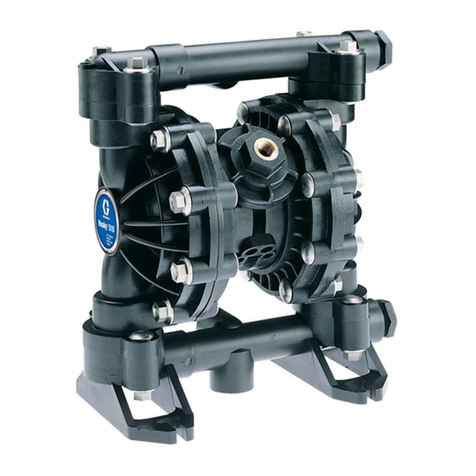
Graco
Graco Husky 515 D51 Series instructions
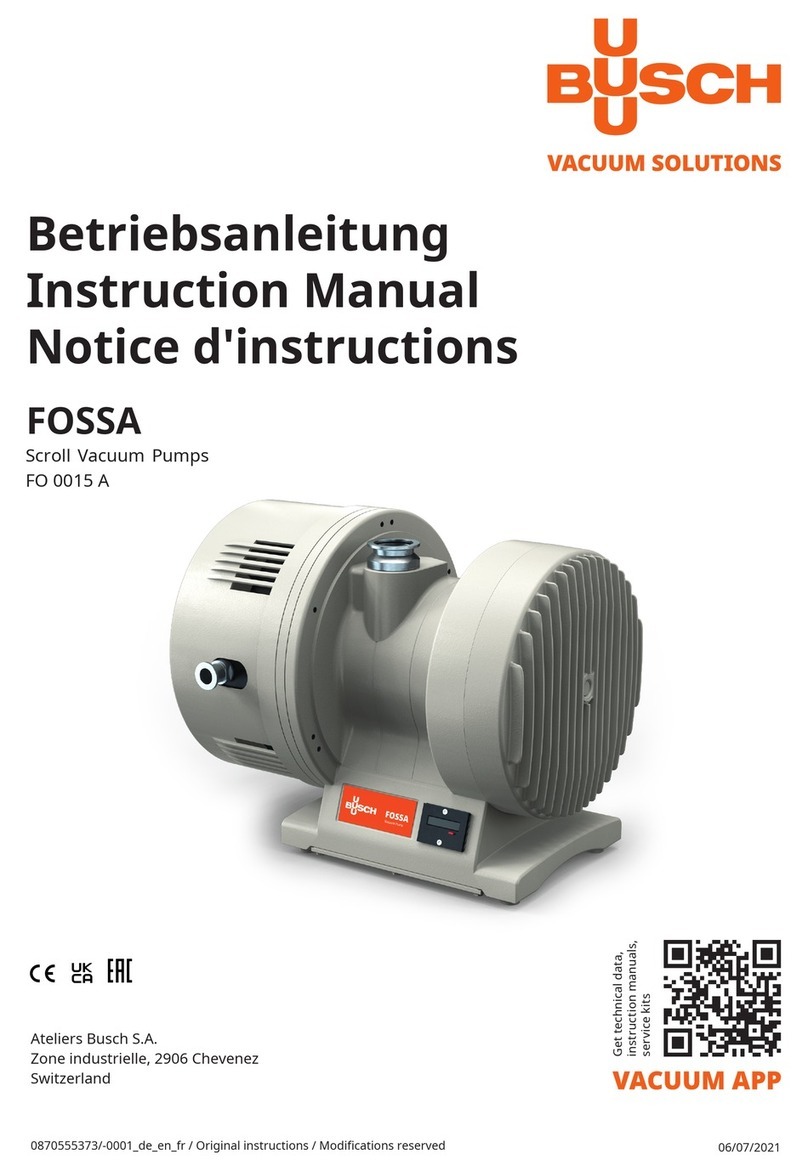
BUSCH
BUSCH Fossa FO 0015 A instruction manual

Roberts Gorden
Roberts Gorden EP 100 Brochure & specs
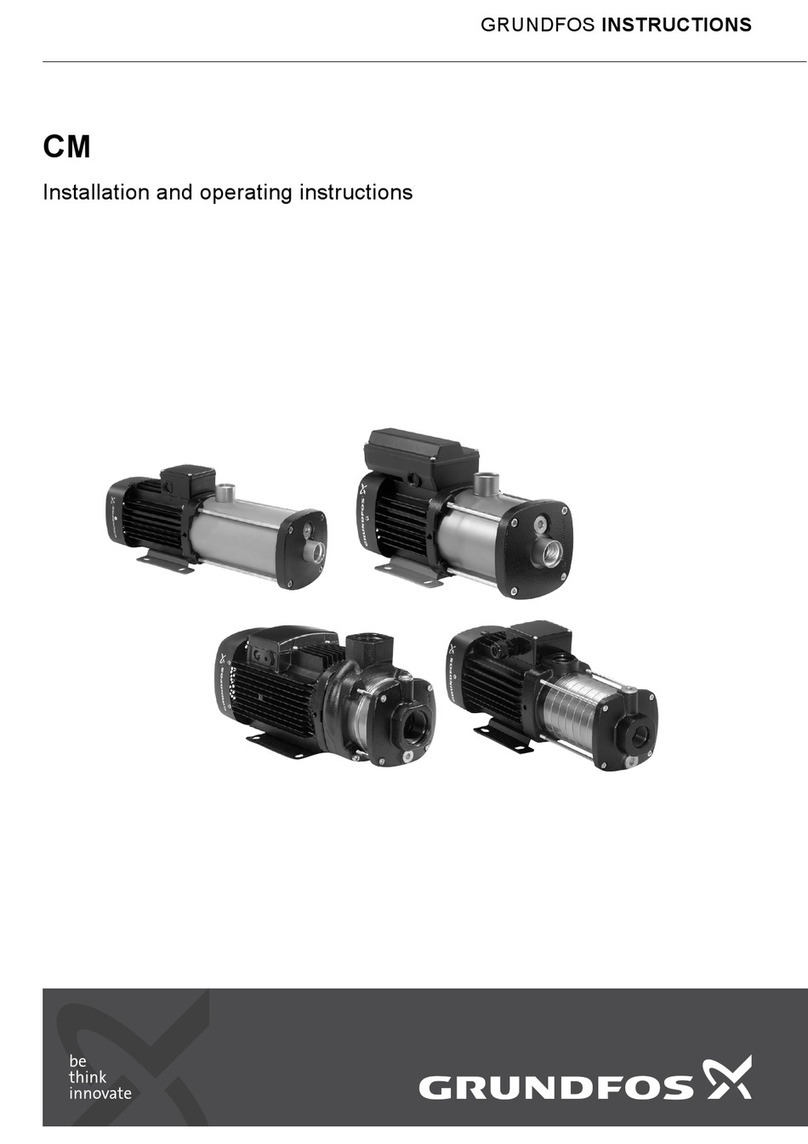
Grundfos
Grundfos CM series Installation and operating instructions

Frymaster
Frymaster SDU 50 90 quick start guide
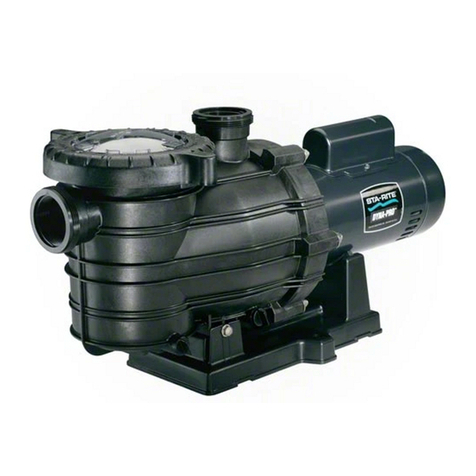
STA-RITE
STA-RITE DYNA-WAVE MPRA Series owner's manual
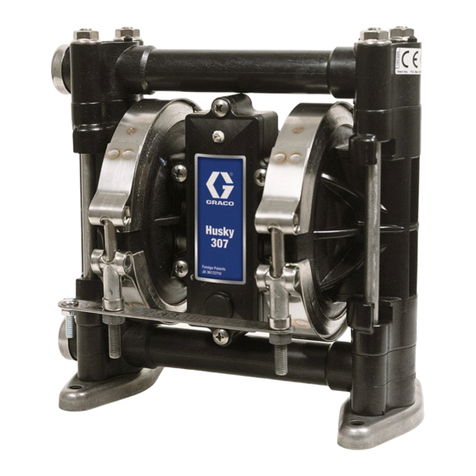
Graco
Graco Husky 307 F Series Instructions-parts list

Liberty Pumps
Liberty Pumps FL152M-3E owner's manual
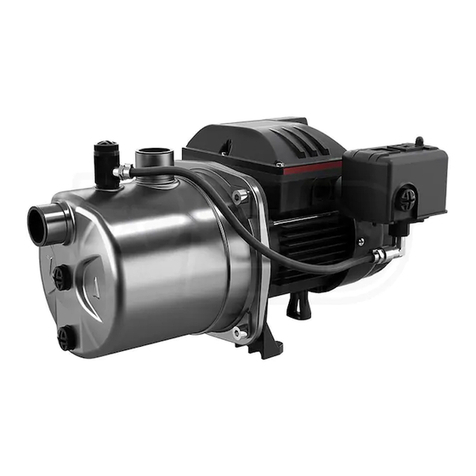
Grundfos
Grundfos JP05S Installation and operating instructions
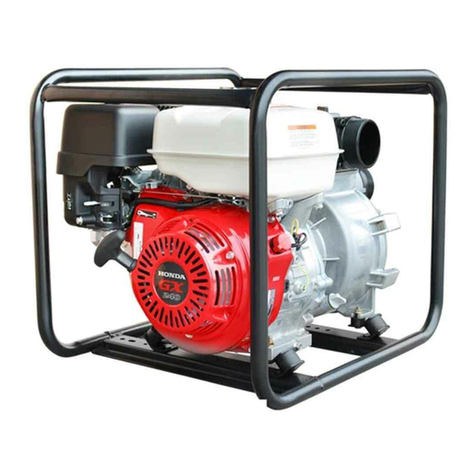
Tomahawk
Tomahawk TW3H Operation manual
Silicon Solar
Silicon Solar AquaJet-Pro-PUMP1224 installation manual
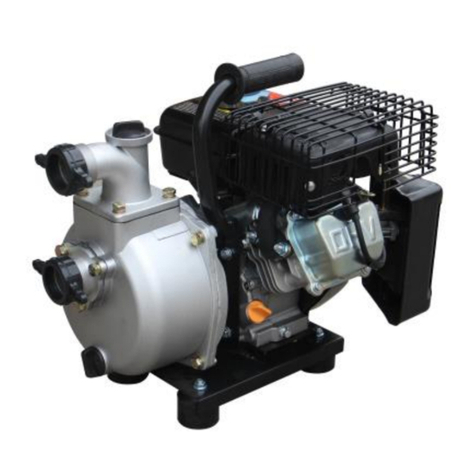
Ribimex
Ribimex Ribiland PRMPP087 Original instructions
